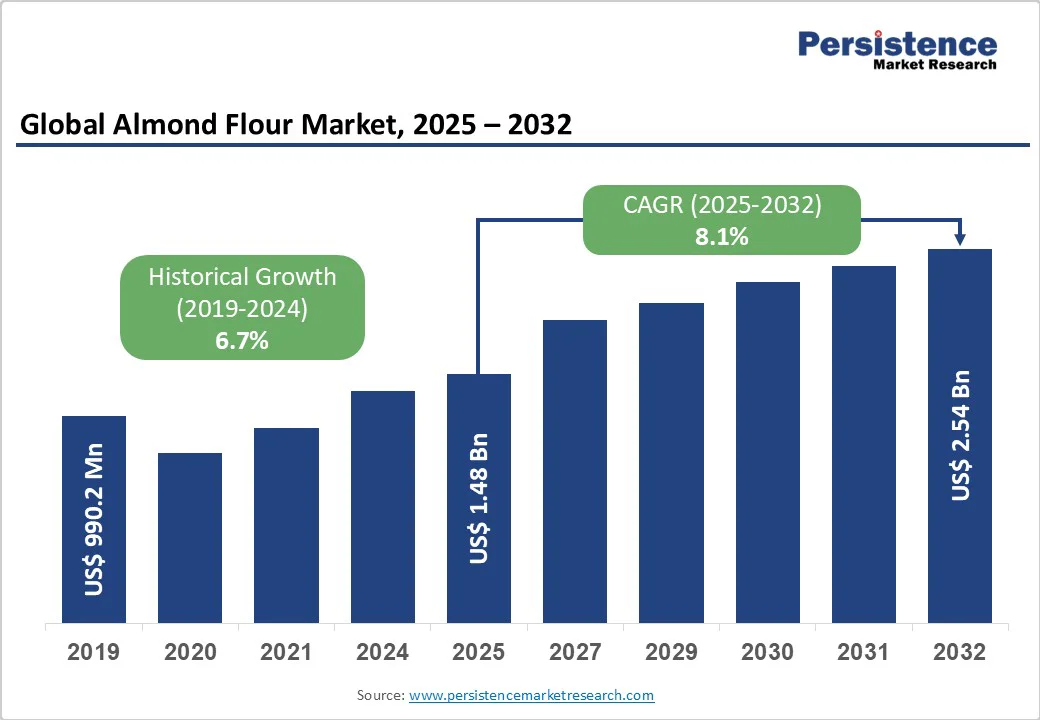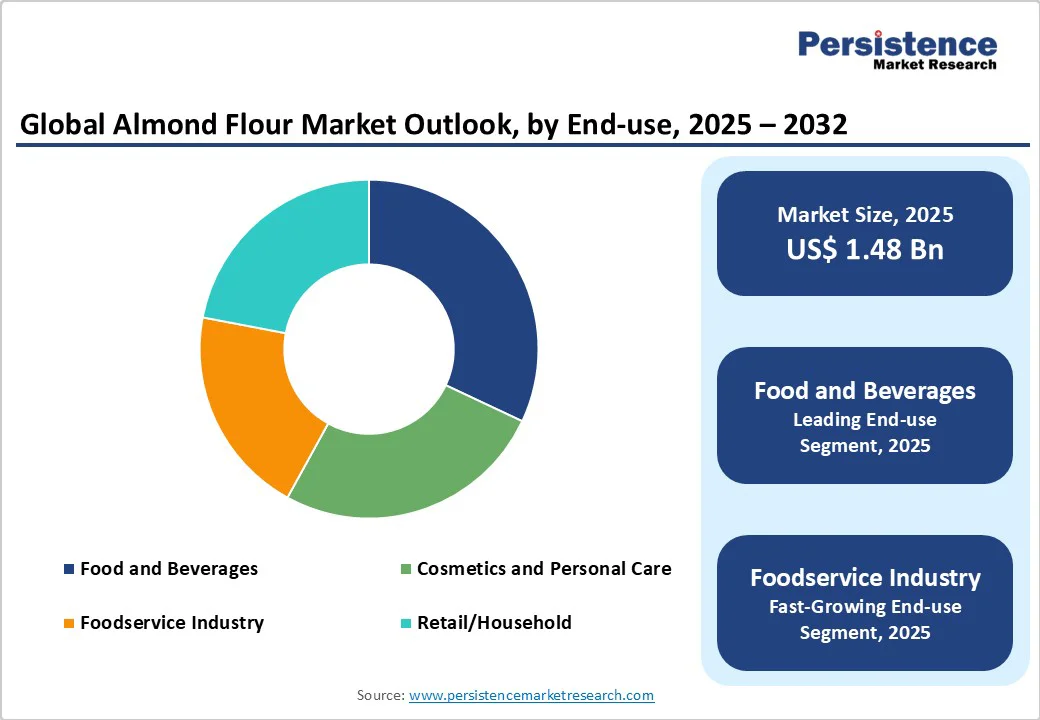ID: PMRREP19594| 195 Pages | 7 Oct 2025 | Format: PDF, Excel, PPT* | Food and Beverages

The global almond flour market size is likely to be valued at US$1.48 billion in 2025 and projected to reach US$2.54 billion by 2032, growing at a CAGR of 8.1% during the forecast period from 2025 to 2032. The global almond flour market is experiencing robust growth, driven by rising demand for gluten-free, low-carb, and protein-rich alternatives in bakery, confectionery, and snack applications.
Consumers seeking healthier diets, plant-based nutrition, and clean-label ingredients are increasingly adopting almond flour. Its versatility in recipes, coupled with rising awareness of almonds’ health benefits such as heart health, weight management, and diabetes control, strengthens market expansion.
| Key Insights | Details |
|---|---|
|
Almond Flour Market Size (2025E) |
US$1.48 Bn |
|
Market Value Forecast (2032F) |
US$2.54 Bn |
|
Projected Growth (CAGR 2025 to 2032) |
8.1% |
|
Historical Market Growth (CAGR 2019 to 2024) |
7.3% |

The growing popularity of ketogenic and low-carb diets is a significant driver for almond flour demand worldwide. Consumers following these diets seek alternatives to wheat-based flours that are both nutritious and low in carbohydrates. Almond flour fits perfectly into this trend, offering high protein, healthy fats, and a naturally low glycemic index, making it ideal for managing blood sugar and supporting weight loss goals. Its ability to deliver a rich texture and nutty flavor in baked goods enhances its appeal in keto-friendly bread, cookies, and pancakes. Additionally, food manufacturers are leveraging almond flour in innovative product launches to cater to health-conscious consumers, further strengthening its role as a cornerstone ingredient in the expanding keto and low-carb market.
In developing regions, the almond flour market faces a key restraint due to low consumer awareness and dietary preferences rooted in traditional staples. The population in Asia, Africa, and parts of Latin America primarily relies on wheat, rice, and maize, which are inexpensive and culturally ingrained. Awareness of gluten-free, keto, or paleo diets remains limited to urban elites and expatriate communities, while the majority of consumers perceive almond flour as an unfamiliar and unnecessary premium product. In addition, limited marketing efforts, weak distribution networks, and lack of product education restrict exposure to almond flour’s health benefits. This knowledge gap slows adoption, preventing almond flour from achieving the same acceptance and growth seen in North America and Europe.
The premium and organic almond flour segment is gaining significant traction as consumers increasingly prioritize health, sustainability, and ethical sourcing. Certified organic, non-GMO, and fair-trade almond flours appeal to high-end consumers willing to pay a premium for quality and transparency. These products not only offer superior nutritional value but also align with growing environmental and social responsibility trends, including sustainable farming and ethical labor practices. Brands can differentiate through unique certifications, traceable supply chains, and artisanal processing techniques, creating a strong trust factor. Additionally, this segment caters to niche markets such as gourmet baking, clean-label snacks, and wellness-focused meal kits, making it a high-potential growth avenue in the global almond flour market.
The Organic by Nature segment is leading in the global almond flour market due to the rising consumer preference for natural, chemical-free, and health-focused ingredients. Health-conscious consumers increasingly seek products free from pesticides, GMOs, and synthetic additives, which positions organic almond flour as a trusted choice. Its perceived nutritional benefits, such as higher antioxidant content and cleaner production processes, further drive adoption. Additionally, the surge in vegan, keto, and gluten-free diets fuels demand for high-quality organic almond flour. Premium branding, certifications, and growing awareness of sustainable farming practices have reinforced this segment’s dominance in both retail and online channels.
The blanched segment leads the global almond flour market due to its superior quality, smooth texture, and versatility in premium baking and confectionery applications. Blanching removes the almond skin, resulting in a fine, light-colored flour that enhances product appearance and taste. Bakers and food manufacturers prefer it for cakes, pastries, and gluten-free recipes, as it integrates easily and provides a consistent texture. Additionally, consumer preference for refined, aesthetically appealing, and nutrient-rich products drives demand. The growing trend of low-carb, keto, and paleo diets further boosts blanched almond flour adoption, solidifying its dominant market position.

In North America, particularly the U.S., almond flour demand is surging due to rising health consciousness and a shift toward gluten-free, keto, and paleo diets. Consumers increasingly prefer clean-label, non-GMO, and organic products, driving manufacturers to innovate with premium blanched and natural almond flours. The proliferation of home baking, fueled by social media trends and recipe sharing, has further added to market expansion. Retailers are responding with ready-to-use almond flour blends and value-added packaging for convenience. Moreover, foodservice sectors, including cafes and bakeries, are incorporating almond flour into protein bars, desserts, and specialty baked goods. This combination of health trends, convenience, and premiumization solidifies North America as the leading growth hub for almond flour.
Asia Pacific almond flour market is witnessing rapid growth, driven by rising disposable incomes, increasing health awareness, and a shift toward Western dietary trends. Urban consumers in countries like China, Japan, India, and South Korea are adopting gluten-free, keto, and low-carb lifestyles, fueling demand for almond-based products. E-commerce platforms and modern retail chains are making premium and organic almond flours more accessible, while social media and influencer-led cooking trends encourage home baking with healthier ingredients. Additionally, the rising popularity of plant-based diets and functional foods supports market expansion. Local manufacturers are gradually introducing region-specific blends and fortified almond flours, creating unique offerings that cater to taste preferences and nutritional expectations, positioning the Asia Pacific as a fast-emerging market.

The global almond flour market is highly competitive, characterized by intense innovation and product differentiation. Leading players focus on high-quality, organic, and non-GMO flours, while premium and specialty variants such as flavored or fortified almond flours gain traction. Companies are investing in advanced processing techniques, attractive packaging, and expanded distribution through retail and e-commerce channels to enhance market presence. The growing demand for gluten-free, keto, and health-oriented products drives continuous product development.
The global market is projected to be valued at US$1.48 Bn in 2025.
The global almond flour market is driven by several key factors. Rising health consciousness and dietary trends such as gluten-free, keto, and paleo diets are fueling demand for almond flour as a nutritious alternative to wheat flour.
The global market is poised to witness a CAGR of 8.1% between 2025 and 2032.
Developing almond flours enriched with protein, fiber, or micronutrients for fitness and wellness markets.
Blue Diamond Growers, Bob’s Red Mill Natural Foods, Rolling Hills Nut Company, Treehouse California Almonds, LLC, and others.
| Report Attribute | Details |
|---|---|
|
Historical Data/Actuals |
2019 - 2024 |
|
Forecast Period |
2025 - 2032 |
|
Market Analysis |
Value: US$ Mn, Volume: Units |
|
Geographical Coverage |
|
|
Segmental Coverage |
|
|
Competitive Analysis |
|
|
Report Highlights |
|
By Nature
By Form
By End-use
By Distribution Channel
By Region
Delivery Timelines
For more information on this report and its delivery timelines please get in touch with our sales team.
About Author